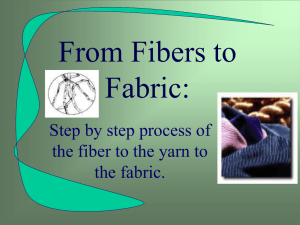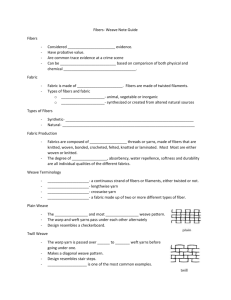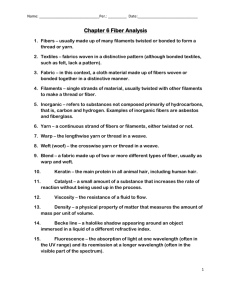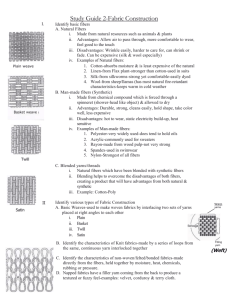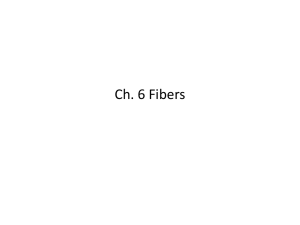Fibers as Evidence
advertisement
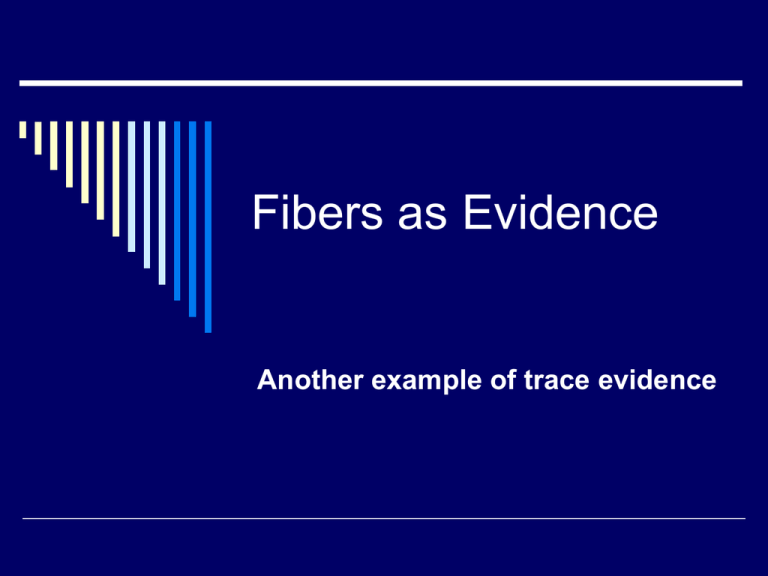
Fibers as Evidence Another example of trace evidence What is a Fiber? According to the FBI, a fiber is the “smallest unit of a textile material that has a length many times greater than its diameter”. Fabric and fiber are NOT the same. Fabric is the type of material and fibers are the threads that are woven to create the fabric. The are two types of fibers: natural and man-made (synthetic) Natural Cotton Linen Wool Mohair Cashmere Silk Man-Made Polyester Rayon Nylon Acetate Acrylic Spandex Classification of Natural Fibers Natural fibers are classified based on their origin. The three classifications for natural fibers are: 1. Vegetable/Plant 2. Animal 3. Mineral Vegetable or Plant Fibers The most common plant fiber is cotton. The wide-use of undyed white cotton in clothing and other fabrics has made this fiber meaningless as evidence. However, when the cotton is dyed with a combination of colors, the evidentiary value is increased. Cotton fibers are ribbon-like and twist at irregular intervals. This is a unique trait for cotton. A Microscopic Look at Cotton Other Vegetable/Plant Fibers include: Linen- made from the skin of the stem of a flax plant. Linen fibers are used in clothing, lace and bed sheets. Ramie, Jute and Hemp- also made from the skin of a plant stem, but processed differently from linen. These fibers are mainly used for rope. Kapok- made from the seed pod of a tropical tree. These fibers are used as fillers for pillows, mattresses and toys. A Microscopic Look at Linen, Hemp and Kapok Animal Fibers Animal fibers are the most common natural fiber found at a crime scene. These include: wool, mohair, cashmere, alpaca and mink. The animal fiber that is most commonly used in textile materials is wool. The animal wool most commonly used is a sheep. Wool is used for clothing and carpet. A Microscopic Look at Wool and Cashmere. These are animal hairs so you may notice the medulla and the cuticle. Animal Fibers from Excrement Silk comes from the blind, flightless moth Bombyx mori. After the silkworm hatches, it eats mulberry leaves continuously for 6 weeks. Next, it secretes a clear fluid that hardens into a silk cocoon. This cocoon is separated into silk fibers. A Microscopic Look at Silk Silk has a triangular structure that causes the silk fiber to refract incoming light at different angles. This refraction results in a shimmering, shining appearance. A Mineral Fiber Asbestos is a naturally occurring silicate mineral that is composed of thin fibrous crystals. Asbestos has been used in building materials since the late 19th century. Asbestos has been identified as a carcinogen so use of this material is limited. A Microscopic Look at Asbestos Man-Made/Manufactured Fibers More than 50% of all textiles are created from man-made fibers. Rayon, the first manmade fiber, was created in 1911. Nylon (to the right) followed in 1939. Classification of Man-Made Fibers Man-Made/Manufactured made be classified into two groups: Regenerated Synthetic Regenerated Fibers Regenerated fibers are manufactured from the cellulose of natural raw materials. This cellulose is chemically treated and then forced through the small holes of a spinning jet. Regenerated fibers include: rayon and acetate. Creating Regenerated Fibers Synthetic Fibers Most of the fibers manufactured today are synthetic. Synthetic fibers are polymers or longchained molecules. Polymers exist in numerous forms and varieties. The most common synthetic fibers are nylon, polyester and acrylic. Nylon and polyester are the most common of the man-made fibers. Fibers as Evidence Fibers may be exchanged between two objects or between an individual and an object. Whether or not a fiber is transferred is dependent on the type of fabric(s) involved and the length of time of the contact . Fibers as Evidence (cont) The cross-section of a man-made fiber is manufacturer specific. Some cross sections are more common than others. Unusual cross sections increase the value of the evidence. Fibers as Evidence (cont) Fibers may be dyed before or after they are woven into a fabric. Dye may also be applied to the surface of a fabric. A dye’s color may be absorbed unevenly and may fade over time. All of these factors must be considered when trying to match a crime scene sample with a control sample. The Analysis of Fibers A Microspectrophotometer compares fiber colors through spectral patterns. Chromatography gives a more detailed analysis of the dye composition. Double Refraction determines the value of the refractive index of the fiber. Infrared Spectrophotometry allows infrared analysis of a single strand of fiber while being viewed under the microscope When the fibers become a fabric Fabrics are composed of individual fibers. These fibers may be knitted, woven, bonded, crocheted, felted, knotted or laminated. Most are either woven or knitted. The method used to construct the fabric will determine the amount of stretch, absorbency, water repellence, softness and durability. These characteristics are unique to a fabric. Woven Fabric Woven fabrics are made by interlacing the warp (lengthwise thread) and the weft (crosswise thread). The warp runs the length of the fabric and parallel to the selvage which is the edge of the fabric. The weft crosses over and under the warp threads. Types of weave patterns include: Plain Twill Satin The Plain Weave Simplest and most common weave Warp and weft pass under each other alternately Create even patterns of 1/1 and 2/2 Design resembles a checkerboard The Twill Weave Created by passing the warp thread over one to three weft threads before going under. Makes a diagonal weave Design resembles a stair step pattern Denim is the most obvious example The Satin Weave The interlacing is not uniform Interlacing weave passes over four or more yarns Satin is the most obvious example Knitted Fabric Knitted fabrics are made by interlocking loops into a specific arrangement. It may be one continuous thread or a combination of threads. The yarn is formed into successive rows of loops. The Weave Pattern and Transfer A tightly woven or knitted fabric “sheds” less than a loosely woven or knitted fabric. Some textile materials such as leather do not transfer fibrous material. The age and condition of the fabric will affect the amount of fiber transfer. How often and for how long a fabric was manufactured is also important to an investigation. Ripped Fabric If fabric evidence is ripped or torn, and both pieces are collected, the edges will be examined under a comparison microscope. The weave pattern must match. Collection of Fiber Evidence Fibers that are visible and attached to an object should be photographed, drawn and described. Then the entire object should be packaged. If fibers are visible and loose they should be carefully removed with clean tweezers and packaged in a paper bindle. Collection of Fiber Evidence If the investigator suspects that an object has fiber evidence, but it is not visible to the naked eye, the object will be sent to the lab where tape will be used to collect any loose fibers. If loose fibers are in a victim’s hair, the hair should be combed over clean paper. Collection of Fabric Evidence Bag fabric items individually in paper bags. Make sure that different items are not placed on the same surface before being bagged. The Wayne Williams Case The Wayne Williams case (pg. 100-110 in the textbook) was solely based on hair and fiber evidence. The fibers were unique in color and cross-sectional area. Williams continues to insist that he is innocent.
